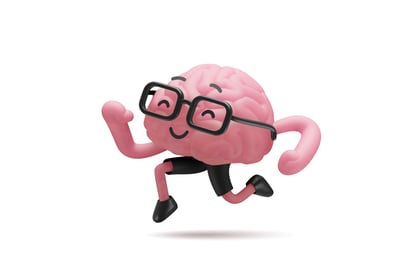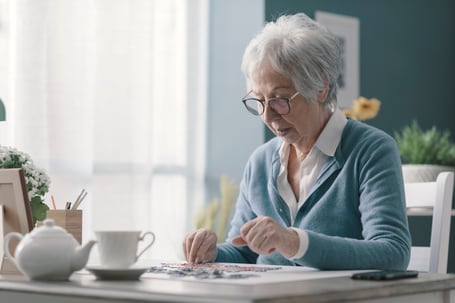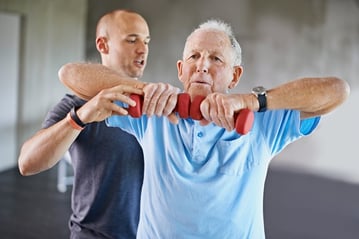 As we age, physicians and specialty doctors will talk to you about exercise and eating a well-balanced diet. We sometimes forget that brain health is just as important. Concentration on moving or getting 30 minutes of exercise per day, and strength training 2-3x a week, but is there any emphasis on brain exercises? If so, what does it look like? Are your residents participating in an craft or art? Are they doing word or cross word puzzles, easy math, or reading aloud? Are they resting their mind, or meditating?
As we age, physicians and specialty doctors will talk to you about exercise and eating a well-balanced diet. We sometimes forget that brain health is just as important. Concentration on moving or getting 30 minutes of exercise per day, and strength training 2-3x a week, but is there any emphasis on brain exercises? If so, what does it look like? Are your residents participating in an craft or art? Are they doing word or cross word puzzles, easy math, or reading aloud? Are they resting their mind, or meditating?
We all fear losing some of our memory and cognitive function. As we age, it is normal to feel a sense of insecurity when we misplace our phone or keys, or even forgetting a step in a craft that you’ve done for many years. There are a lot of brain health exercises that the residents can participate in, it is just finding the ones they love to do where it is easy, slightly complex, but enjoyable.
There are many simple activities that we can do to engage our brain. Here are a few easy ways to engage the brain, and possibly decrease risk of memory loss. An easy way to help brain health is engaging with your neighbor, a friend, or a family member and discussing current life events, attending a church service, or maybe a music/ theater event. Another simple exercise is handwriting notes or sending handwritten cards. Handwriting engages the brain more than sending a text or an emoji.
And of course, there are “brain” games that we can play on our phones or iPads. Look at your phone and check out the word games, or the simple math problems. Simple math problems can engage the prefrontal cortex of the brain. Doing simple math is an easy way to exercise your mind. Keep in mind, when it becomes too stressful, you need to decrease the complexity of math problems. Stress is not beneficial for your mind and body.
Another awesome thing you can do for your brain health is to learn a new craft or perfecting your current craft. Is there another advance step you can put into your current craft or skill to make it more challenging, such as learning a new stitch or a new painting style? These ideas can give you a sense of control and purpose. Lastly, meditate and rest your mind, if you love sleep, SLEEP, it is good for your body and mind.
So how are you engaging with the residents in brain health or brain classes? What sorts of activities or classes are you hosting to entice the residents?


 The neuromotor connection refers to the intricate interplay between the nervous system and motor functions, encompassing a complex network of signals that regulate movement, coordination, and balance. In older adults, this connection undergoes natural changes, influenced by factors such as age-related neuronal alterations, decreased muscle mass, and changes in proprioception. The neuromotor systems can effect the human body in many different subsets of health.
The neuromotor connection refers to the intricate interplay between the nervous system and motor functions, encompassing a complex network of signals that regulate movement, coordination, and balance. In older adults, this connection undergoes natural changes, influenced by factors such as age-related neuronal alterations, decreased muscle mass, and changes in proprioception. The neuromotor systems can effect the human body in many different subsets of health.
 THE BRAIN: the most important organ in our body, is often the most forgotten when we think of training. Why does the brain always seem to slip through the cracks? We can’t stop talking about BMI, body fat percentage, heart rate reserve, and all these other buzz words in the fitness industry. Now you’re probably thinking “but isn’t exercise good for the brain?” and you’d be right but there is more to it than that. We aren’t specifically targeting our brain, we’re focused on our muscles, our heart and the brain is just getting a splash of the love it deserves. That’s something I’d like to change! And we can do that in the gym and at home.
THE BRAIN: the most important organ in our body, is often the most forgotten when we think of training. Why does the brain always seem to slip through the cracks? We can’t stop talking about BMI, body fat percentage, heart rate reserve, and all these other buzz words in the fitness industry. Now you’re probably thinking “but isn’t exercise good for the brain?” and you’d be right but there is more to it than that. We aren’t specifically targeting our brain, we’re focused on our muscles, our heart and the brain is just getting a splash of the love it deserves. That’s something I’d like to change! And we can do that in the gym and at home. As we age there are many different changes that start to happen to our brain such as shrinkage, vasculature and cognition. With age, the brain shrinks and changes occur at all levels, from chemicals to morphology. Stroke, lesions, and dementia are all more common as people get older, as is memory impairment. Fortunately there are quite a few things we can do to help prevent or slow the process of some of those changes from happening. Regular exercise, a good diet, and low to moderate alcohol consumption, all of which minimize cardiovascular risk, appear to help the aging brain, as does increasing cognitive exertion in the form of schooling, games or meaningful activities. Physical and mental health may be the best defense against the effects of aging on the brain.
As we age there are many different changes that start to happen to our brain such as shrinkage, vasculature and cognition. With age, the brain shrinks and changes occur at all levels, from chemicals to morphology. Stroke, lesions, and dementia are all more common as people get older, as is memory impairment. Fortunately there are quite a few things we can do to help prevent or slow the process of some of those changes from happening. Regular exercise, a good diet, and low to moderate alcohol consumption, all of which minimize cardiovascular risk, appear to help the aging brain, as does increasing cognitive exertion in the form of schooling, games or meaningful activities. Physical and mental health may be the best defense against the effects of aging on the brain.
 Many seniors fear cognitive decline more than any other disease associated with aging. The good news is that engaging in activities that support brain health and brain function can reduce seniors’ risk for cognitive decline and dementia. In fact, training your brain is kind of like training your body with regular exercise, and it can really complement your fitness programs with proper planning. Not sure where to start? Here are five steps to create a focus on brain training in your senior living community.
Many seniors fear cognitive decline more than any other disease associated with aging. The good news is that engaging in activities that support brain health and brain function can reduce seniors’ risk for cognitive decline and dementia. In fact, training your brain is kind of like training your body with regular exercise, and it can really complement your fitness programs with proper planning. Not sure where to start? Here are five steps to create a focus on brain training in your senior living community.